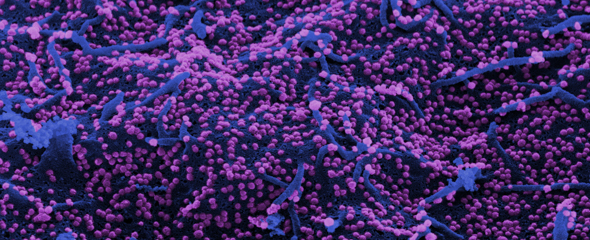To deal with the Corona pandemic and its effects, we need scientific knowledge and solutions that go far beyond health research. The pandemic has revealed the stress limits of our critical infrastructures and dependencies on global supply chains. Helmholtz scientists have been researching the spread of the coronavirus and developing active substances and drugs against COVID-19 since January 2020. Helmholtz is now taking the next step with the Helmholtz-wide campaign “The Corona Pandemic: Awareness, Management, Prevention”. In interdisciplinary collaborative projects, experts from all six Helmholtz research fields are developing holistic approaches to tackling the pandemic based on the latest findings gained from the corona crisis.
Model system for future pandemics
Researchers from seven Helmholtz centres are working together with universities and industry partners on the project „Virological and immunological determinants of COVID-19 pathogenesis – lessons to get prepared for future pandemics (CoViPa)". Among other things, they want to examine the mechanisms of the disease process, which strategies could be used to effectively combat the virus and what the risks are of other pathogens making the jump from animals to humans. The German Cancer Research Centre in the Helmholtz Association (DKFZ) is coordinating the project. “We are considering SARS-CoV-2 as a model system for future pandemics caused by similar pathogens. Based on this, we want to gain insights into the disease mechanisms by means of immunological and virological analyses in order to develop preventive measures. At the same time, we’re using robotics and high-throughput data analysis to be better prepared for pandemic outbreaks in future or to better assess the risk of a pandemic,” says Prof Ralf Bartenschlager (DKFZ). Together with virologist Prof Ulrike Protzer from Helmholtz Zentrum München – German Research Centre for Environmental Health (HMGU), he is the scientific spokesperson for the CoViPa project.
HZI research groups examine active substances and immune reactions
Two of the CoViPa subprojects are being conducted at the Helmholtz Centre for Infection Research (HZI) in Braunschweig. Prof Luka Cicin-Sain, head of the HZI department “Viral Immunology”, studies the function of various immune cells and their communication via messenger substances during a SARS-CoV-2 infection. For the project, he collaborates with Prof Markus Landthaler’s group at the Max Delbrück Center for Molecular Medicine (MDC) in Berlin. In addition, the scientists are testing new antiviral agents. The active substances block a host protein that the viruses need to reproduce and could therefore be widely effective. Such agents contribute significantly to pandemic preparedness.
Another CoViPa project is being conducted in cooperation of the HZI research groups “Immune Regulation” by Prof Dunja Bruder and “Innate Immunity and Infection” by Prof Andrea Kröger. Together with their colleague Prof Ana Zenclussen from the Helmholtz Centre for Environmental Research (UFZ) in Leipzig, the scientists are examining mechanisms by which pandemic viruses such as SARS-CoV-2 overcome natural barriers of the respiratory tract and the placental barrier. Among other things, they are also analysing the differences and similarities between SARS-CoV-2 and other viruses such as influenza A and the Zika virus, which have also caused epidemics and, as in the case of the influenza virus, pandemics in the past. The findings could be used in future to prevent and contain pandemics involving new viral pathogens.
COVID-19 transmission through the air
The collaborative project “Airborne Transmission of SARS Coronavirus – From Fundamental Science to Efficient Air Cleaning Systems (CORAERO)” focuses on researching and preventing the transmission of the virus through aerosols and droplets. “We’re planning research and technology transfer for innovative technologies that can remove and inactivate SARS-CoV-2 and other viruses in the air and on surfaces,” says scientific coordinator Prof Claudia Traidl-Hoffmann from the Helmholtz Zentrum München. Experts from the fields of medicine, biology, physics, chemistry, materials sciences, engineering and social sciences are working together to develop technologies to stop the spread of viruses. These technologies could be used in schools, businesses, public transport and public places, thus preventing drastic measures such as school closures in future.
The Helmholtz-wide campaign is financed by the Initiative and Networking Fund. “We are pooling all of our research strengths to better understand, overcome and prevent pandemics and analogous challenges such as the current COVID-19 pandemic in future,” explains Prof Otmar D. Wiestler, President of the Helmholtz Association. “Our goal is to find out how we as a society can prepare ourselves for such exceptional situations. We can only achieve this with interdisciplinary, strategically oriented approaches that include practical applications from the very beginning.”
A core component of the collaborative projects is an integrated transfer concept: Societal actors are involved in defining solution-oriented questions and in implementing the research project from the very beginning. An interdisciplinary panel of experts from the fields of virology, natural and engineering sciences, innovation management and commerce selected the two projects CoViPa and CORAERO for funding from a total of eleven proposals.
To the pressrelease of Helmholtz Association of German Research Centres (German).

